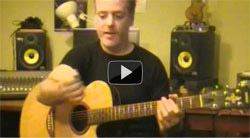
| HOME | ABOUT | GUITAR LESSONS | STUDENT TESTIMONIALS | CONTACT |
Student Testimonial "After Jaydens first lesson, he got into the car and said' I have just learnt more in that one lesson than I learnt the whole time at school lessons'. Mum was very pleased. Anthony has proven himself to be professional, trustworthy, knowledgeable and passionate musician. My son actually practices. I recommend Anthony as a teacher." Read More Guitar Student Testimonials
|
|||||||||||||
Practicing GuitarSo you want to learn guitar and have played a little bit and learnt a few chords but what exactly should you practice and how often? The old saying is true “practice makes perfect” whether your learning a musical instrument like the guitar or developing your skills in sport like tennis for example. |
||||||||||||||
|
The trick to getting the most out the time you spend practicing guitar is to use your time effectively and practice regularly on a daily basis or at leat on most days of the week. In general it is better to practice 30 minutes on a daily basis verses cramming in 2-3 hours once a week on a Saturday afternoon. This is due to how the brain works. Daily repetition of a song or musical exercise will stay in your mind more effectively if practice is carried out every day. You’ll find that your muscle memory will develop more quickly too. Muscle memory is a form of procedural memory that involves consolidating a specific motor task into memory through repetition. When a movement is repeated over time, a long-term muscle memory is created for that task, eventually allowing it to be performed without conscious effort. This is how guitarists learn to automatically play the right chord shapes and scale patterns on the guitar with minimal effort. Years of practice and repetition has ingrained these actions that the fingers use to play the guitar into the guitarists hands and minds so that they become second nature just like riding a bicycle or touch typing. The next part is what should you practice? The short answer is whatever you’re bad at and need to work on! Every student is at a different level of playing so what they need to focus on will be different from the next student. |
 |
|||||||||||||
For beginners the practice may involve practicing the basic skills of using the pick on individual strings, strumming chords and learning chord shapes and practicing changing from one chord shape to the next. For intermediate guitar students practice can involve learning scales and music reading, learning the chord changes and strumming rhythms for song or a melody or working on playing arpeggio patterns cleanly and smoothly. With more advanced students practice could be on developing music reading skills, improvising guitar solos overs blues or other chord changes or advanced techniques like tapping or sweep picking. In terms of a practice routine or schedule it is best to start your practice working on what you find the most difficult or challenging for example a new technique like finger picking or reading music. Then progress to material that you’re OK at but not great such as a song you’ve been working on the past few days and almost have down properly. Following this you can finish off your practice with something a bit easier or more fun like playing a song you know well or improvising a blues solo over a backing track for more advanced guitarists. If you stick with this practice routine you will develop your playing and broaden your set of guitar skills more quickly than if you put off what your really need to wok on towards the end of your practice as you’ll often find that you’re getting tired or you’re running out of practice time. If you’re playing what you already know it’s not really practice. Practice should sound awkward and ugly as you’re practicing what needs to be developed and made better! |
||||||||||||||
For more information or to book a lesson call Anthony on 0408 058 525 or email melbourneguitarlessons@gmail.com HOME | ABOUT | GUITAR LESSONS | GUITAR STUDENT TESTIMONIALS | LINKS | CONTACT |
||||||||||||||

